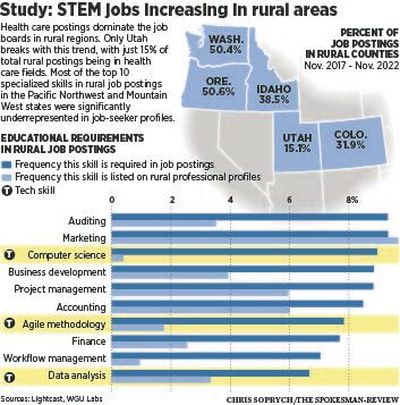Health care and tech jobs on the rise in rural northwest

Half of all job postings in rural Washington are in health care, and STEM opportunities are growing rapidly, according to a recent report.
To understand how the employment landscape shifted during the pandemic, a team of researchers at Western Governors University looked at jobs data for the last five years in the rural regions of five Western states.
The report, “Shifting Winds: Examining Employment Trends in Rural Northwest Regions,” showed that jobs in science, technology, engineering and math grew 183% in rural areas versus a 61% increase in urban areas. It also found a stark mismatch between job requirements and the skills local applicants listed.
“The purpose of our research is to inspire those who are looking for strong paying jobs, markets that are in demand, areas for which you can see value in your work and a strong return on your investment,” said Tonya Drake, northwest regional vice president at WGU.
The study analyzed job listing data from Lightcast – a Moscow, Idaho-based market analytics company – professional profiles and Bureau of Labor Statistics data filtered to rural counties in Washington, Oregon, Idaho, Utah and Colorado. These states had among the country’s fastest-growing rural populations and rural economies in the years preceding the pandemic.
“Rural economies, once dominated by agriculture, are now more diverse,” the report said.
Health care leads the way. The sector added 20,000 jobs in the five states from 2017 to 2022. Over those years, 50.4% of all new rural jobs in Washington were in health care. The figure was 38.5% in Idaho.
“Health care, no matter where you are in rural Washington or Idaho is a great opportunity and in very high demand right now,” Drake said.
That’s true at Newport Hospital in Newport, Washington, about 50 miles northeast of Spokane.
The hospital has 19 jobs openings, with five more offers pending. That’s not bad for a hospital of about 400 employees, human resources director Joseph Clouse said, but it’s higher than the pre-pandemic average.
There were as many as 40 openings at the peak of the pandemic.
Clouse said nurses with specialties are harder to find. Most people don’t want to commute very far.
“It’s not an issue of wages,” he said. “We pay as much as a big urban area. It’s just, do people want to drive here?”
The hospital lost a lot of nurses during the pandemic. Some made career changes, some became traveling nurses and some followed skyrocketing wages and sign-on bonuses to other hospitals.
Now that growing wages have stabilized, Newport Hospital is drawing more talent back to the area, Clouse said. They are hiring recent graduates more now than in the past.
After an initial drop at the beginning of the pandemic, demand for tech jobs in rural areas outpaced urban growth. However, there remain more opportunities in urban areas.
In Washington, urban STEM job postings increased by 5,674 from January 2018 to January 2022 – a 49% increase. In contrast, rural Washington gained only 287 STEM postings over the same time period – a 113% increase.
In rural Idaho, software developers went from the 12th most-wanted job to the second.
“That’s a really dramatic shift in demand for a pretty specific and technical skill set over a short period of time in a place where we don’t typically think about software developers,” said Betheny Gross, director of research for WGU Labs.
And while remote work increased across many sectors during the pandemic, only a fraction of STEM jobs are fully remote.
“That companies seem to want in-person talent may suggest that companies still prefer a workforce that meets together, that only local talent can understand their local needs, or both,” the WGU report said.
A key finding by the report was a misalignment of desired skills and local talent.
“We saw a real mismatch between the kinds of skills that individuals in rural communities listed on their profiles and resumes, and what positions in demand are requiring now when it came to technology skills,” Gross said.
In the top 10 desired skills in rural job postings from 2021-22, only marketing is overrepresented in local job seeker profiles. Computer science was in over 8% of job requirements, while less than 1% of job seekers listed that skill.
Another surprise for the researchers was a shift in the requirement for a bachelor’s degree.
The largest share of positions in rural areas do not list any education requirements. Yet a bachelor’s requirement more than doubled from 14% in 2017 to 33% in 2022, overtaking the requirement for a high school diploma or GED.
The requirement for a master’s degree, though a much smaller share, more than doubled to 9%.
At the same time, rural residents generally have less access to education and fewer residents have degrees.
This is an opportunity for local communities and education systems to work toward solutions, Gross said.
As director of the Eastern Washington Area Health Education Center at Eastern Washington University, Jenna McDonald works to bring health care professionals to rural and underserved communities.
She said education and health districts can work together to bring health programs to rural high schools, which can encourage local students to pursue health careers and give them a good head start.
One way WGU is contributing is through a new Learn Where You Live scholarship for students in rural areas who would like to pursue a bachelor’s or master’s degree at the online, nonprofit university.
Rural job seekers should balance high-growth industries against high wages, the WGU researchers said. Considering these two factors, the report concluded that jobs classified as professional, scientific and technical offer the best balance of growth and salaries. These include jobs like accountants, architects, data analysts, engineers and software developers.